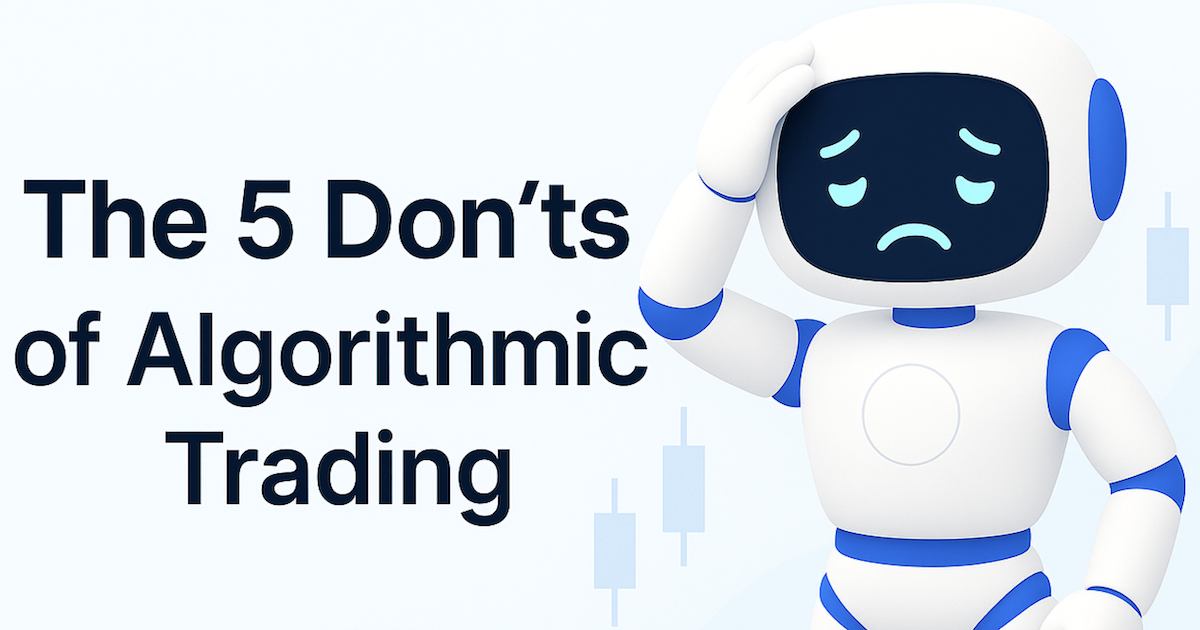When you start out in the world of algorithmic trading, you begin to feel the thrill of seeing your strategy execute trades without you doing a thing, but you also feel the frustration (to put it mildly) when something fails without you knowing exactly why. If you’re reading this, you’ve probably experienced something similar, but don’t worry, it’s completely normal. We’ve all been there—seeing a promising strategy that doesn’t work out as we expected, and we’ve all likely made some of the algorithmic trading mistakes we’ll cover in this article.
Algorithmic trading is a very powerful tool. It allows you to execute strategies consistently, without emotions, and with a speed that is impossible to match manually. But be careful, it also has its problems. It’s not as simple as putting a botinto operation on a platform like TradingView and expecting it to start making money. Before that, you need to have a very good understanding of how it works and what variables can affect it, so you can do it right from the beginning.
That’s why, in this article, we’ll share the 5 most common algorithmic trading mistakes that beginners make, and what’s probably even more important: how to avoid them before they cost you money, time, or motivation. If you’re just starting out, or even if you’ve already done some tests, this guide will help you build more effective, stable strategies that are aligned with your goals.
So let’s get to it. Let’s start with the most important and also the most obvious one.
Mistake 1: Failing to Properly Define Rules Before Automating
One of the most common mistakes is wanting to automate without having a truly defined strategy. Many traders, when they start, rush to create a bot simply because an entry with an indicator like the RSI “worked once” or because they saw a pattern that seemed profitable and that the internet said worked.
The problem is that a bot can’t guess what you want it to do. It only executes instructions that must be very precise and very well-defined. If those instructions are poorly planned, incomplete (you don’t define all possible outcomes), or contradictory, the bot will trade poorly, even if the underlying idea is a good one.

A very simple example that serves the point would be to tell the bot to “buy when there is a good signal”—that won’t work. What is a good signal? RSI below 30? A moving average crossover? Unusual volume? You have to write it as if the bot knows nothing… because it really doesn’t know anything.
How can we avoid it?
- Write your strategy on paper (yes, leave the computer for a little while) with exact conditions and be very specific about every detail you can.
- Define your entry, exit, position size, filters, and other conditions as much as you can.
- Think about different scenarios: What happens if there’s no volume? Or if the price jumps a lot?
- Then translate that logic to the system (like BlueCandle), step by step.
A well-thought-out strategy is not only more profitable, it is also easier to automate, improve, and understand.
Mistake 2: Forgetting to Backtest and Not Validating with Historical Data
It could happen that when you’re all excited to launch a bot directly into the market, you skip a very important step: testing the strategy with historical data. This process, also known as “backtesting,” simulates how your strategy would have behaved in the market.
If you don’t backtest, you could be said to be trading blindly, and that’s one of the big algorithmic trading mistakes. Your robot might work, but only because the market conditions are just right for it to win. But what will happen when the market changes? What if the market is moving sideways? What if there’s a sharp drop or a violent rise?
You also shouldn’t be fooled by the “Cherry Picking” effect—that is, choosing only the periods where the strategy works as valid. The real test is that it works in any scenario within the asset you are testing, and under conditions that are diverse from the ones you planned.
This is one of the big algorithmic trading mistakes, even when you start with artificial intelligence, as it’s common to have problems with the historical data that has been used for the analyses.
How can we avoid it?
- By performing backtests that include a lot of data and that are representative.
- The period in which you run the tests should include periods of high and low volatility, bull and bear trends, and sideways markets.
- Be careful not to adjust the strategy just so that it “looks good” in the past. In machine learning, this is called overfitting, but humans can also do it almost subconsciously.
- Don’t just look at profitability. Also, consider the stability, consistency, and resilience of your robot.
Backtesting doesn’t guarantee success, but it greatly reduces the risk of costly mistakes.
Mistake 3: Failing to Consider Risk Statistics
I think we all start out by only looking at whether our money has increased or decreased after a backtest to know if a strategy is good. We see a strategy that made 20% in a few weeks and think we’ve discovered the Holy Grail of trading. But you also have to ask yourself: What happens if a trade goes wrong?
One of the most important indicators we should look at is the Drawdown, which is the maximum capital decline from a peak. If you’ve gained 20% but the drawdown is 40%, something is wrong. If the strategy isn’t adjusted, we are risking twice as much as we are gaining, and in the long run, this can end badly, making it one of the biggest algorithmic trading mistakes.
You also need to look at metrics for result volatility. If you have a strategy that seems to be able to win a lot, but its volatility is very high and its performance makes huge jumps, you might have to visit your cardiologist frequently.
How can I avoid it?
- Monitor the drawdown in your backtests and live operations.
- Use a position size that is proportional to the total capital, not fixed.
- Look at ratios like the profit factor, Sharpe ratio, or Calmar ratio, which combine return and risk.
- If you see that the robot starts to have strange behaviors, stop it and review the strategy before it’s too late.
Algorithmic trading is a marathon. It’s not just about winning, but about surviving for a long time with consistency.
Mistake 4: Ignoring the Impact of Costs and Real-World Execution
Many times we run backtests that, in theory, seem very profitable, but when we get into real operations, other details arise that can ruin our results. A simple example can be an intraday trading bot; if with each operation it loses 0.1% due to commissions or slippage (price slippage), your bot might not end up in the green even if your operations are correct.
As you may have already realized, this has a greater impact on strategies over very short periods or with high frequency, where there can be many operations in a very short time, and commissions can destroy the entire operation. And this is one of the big algorithmic trading mistakes, since we think that algorithmic trading can make very fast trades and it may be that the profits from each trade are less than the costs. Therefore, it is always important to take into account the costs of each operation, which brokers usually take care of showing you on their pages (such as ibroker or interactive brokers).
You also have to take into account other technical errors, such as bots disconnecting from the broker, slow connections, prices that are updated late, or market conditions that cause your order not to go through as you expected.
You must keep all of this in mind, and while it can’t always be completely avoided, you will at least be aware of the risk in your operations.
How can I avoid it?
- Simulate real commissions in your backtests.
- Include a slippage margin to avoid excessive optimism and thinking you’ll buy at the same price you see in the backtests.
- Use platforms that offer reliable, real-time data and execution (like BlueCandle).
- Set up alerts or monitor your robot to make sure it’s working as expected at all times.
Remember: a piece of paper can handle anything. The real market can’t.
Mistake 5: Lack of Monitoring and Dynamic Adjustments
Many of us think that algorithmic trading is about creating a perfect robot and then kicking back and watching the money roll in. But nothing could be further from the truth. The market is constantly changing, and a strategy that has been working well for months can stop working tomorrow, and you’ll have to make adjustments and figure out why it’s failing.
In addition, as we said before, there can be connection, data, or even execution errors, and if you’re not keeping an eye on your robot, you could be losing money without even realizing it. These are the algorithmic trading mistakes that ultimately cause you to lose all your money and your motivation to continue.
And another important thing: “Monitoring” doesn’t mean being constantly glued to the screen, watching your robot enter and exit trades. It means having mechanisms (alerts to your email, phone, or wherever) to know that everything is in order (and also to act quickly if it isn’t) so you don’t make some of the typical algorithmic trading mistakes.
How can I avoid it?
- Regularly review the performance of each strategy and check the operations to see if they are as we expected.
- Set up automatic alerts that are sent to a place you can access at any time: for example, if the bot stops operating, if the drawdown exceeds a certain level, or if the results deviate too much, send an email with a specific subject.
- Use tools like BlueCandle, which allow you to visualize in real time what your bot is doing, compare its results with what was expected, and adjust it to send you alerts when something happens with your robot.
- Establish review times (daily or weekly, for example) to adjust parameters if the market changes and adapt quickly.
A robot doesn’t replace you as a trader; it’s only a tool that improves you. You are still the strategist.
Conclusion
As we now know, trading is not simple, nor is algorithmic trading a magic wand that grants wishes. What algorithmic trading is, is a powerful tool that, if used well and intelligently, can help you a lot. Avoiding these five algorithmic trading mistakes will save you time, money, and frustration.
Keep in mind that the main thing is to properly define your strategies, test them extensively before launching the robot, control risk well, run realistic tests, and always be aware that your robot may need your help. With these simple principles, you’ll be closer to building automated systems that are profitable, stable, and adaptable to the market.
Are you ready now to put your ideas into action? With BlueCandle, you can create, test, automate, and monitor your strategies without needing to know how to program, and save yourself from these five algorithmic trading mistakes. It’s designed for real traders, not for geniuses from Silicon Valley.



No Comments